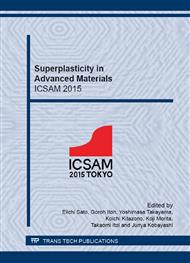[1]
K. A. Padmanabhan, Superplasticity, Springer-Verlag Berlin Heidelberg, New York, (1980).
Google Scholar
[2]
H.L. Xing, C.W. Wang, K.F. Zhang, Z.R. Wang, Recent development in the mechanics of superplasticity and its application, J. Mater. Process. Technol. 151 (2004) 196- 202.
Google Scholar
[3]
Young-Seon Lee, Sang-Yong Lee, Jung-HwanLee, A Study on the process to control the cavity and the thickness distribution of superplastically formed part, J. Mater. Process. Technol. 112 (2001) 114-120.
DOI: 10.1016/s0924-0136(01)00564-7
Google Scholar
[4]
Dong H. Shin, Yeon J. Joo, Woo J. Kim, Chong S. Lee, Microstructural evolution during superplastic deformation of a 7475 Al alloy, J. Mater. Sci. 33 (1998) 790-784.
DOI: 10.1023/a:1004383420256
Google Scholar
[5]
A. Smolej, M. Gnamus, E. Slacek, The Influence of the thermo mechanical processing and forming parameters on superplastic behaviour of the 7475Aluminum alloy, J. Mater. Process. Technol. 118 (2001) 397-402.
Google Scholar
[6]
Taharsahraoui, Mohamedhadji, Nacerbacha, Riadbadji, Superplastic deformation behavior of 7075 aluminum alloy, The International J. Mech. Eng. Perform. 12 (2003) 398-401.
Google Scholar
[7]
Xing Huilin, Zhang Kaaifeng, Qiao Yu, Z.R. Wang, An advanced superplastic sheet – forming machine controlled by microcomputer, J. Mater. Process. Technol. 55 (1995) 43-47.
DOI: 10.1016/0924-0136(95)01810-7
Google Scholar
[8]
Abdel- Wahab El-Morsy, Ken-ichi Manabe, FE simulation of rectangular box forming using material characteristics from the multi-dome forming test, J. Mater. Process. Technol. 125 (2002) 772-777.
DOI: 10.1016/s0924-0136(02)00389-8
Google Scholar
[9]
G. Kumaresan, K. Kalaichelvan, Multi-dome test for determining the strain rate sensitivity index of a superplastic 7075 Al alloy sheet, J. Alloy. Comp. 583 (2014) 226-230.
DOI: 10.1016/j.jallcom.2013.08.194
Google Scholar
[10]
G. Kumaresan, K. Kalaichelvan, Experimental investigation on the rectangular cup formability of Al-alloy sheet by superplastic forming technique, J. Scien. Ind. Res. 73(2014)46-50.
DOI: 10.4028/www.scientific.net/amr.622-623.442
Google Scholar
[11]
Kinji Hirai, Hidetoshi Somekawa, Yorinobu Takigawa, Kenji Higashi, Superplastic forging with dynamic recrystallization of Mg-Al-Zn alloys cast by thixo-molding, Scripta. Mater. 56 (2007) 237-240.
DOI: 10.1016/j.scriptamat.2006.09.037
Google Scholar
[12]
Z. Horita, M. Furukawa, M. Nemoto, A.J. Barnes, Superplastic forming at high strain rate after severe plastic deformation, Acta. Mater. 48(2000) 3633-3640.
DOI: 10.1016/s1359-6454(00)00182-8
Google Scholar


